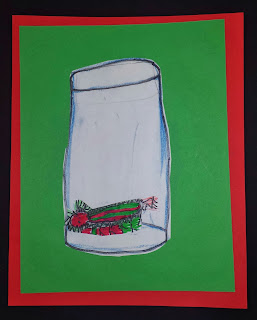3 Class Periods
 |
| Gustav Klimt's The Cradle, First Grade Art Lesson |
About the Artist:
Gustav Klimt was born in Austria in 1862. His family was very poor. His father provided the little income they had by being a gold engraver. Gustav was passionate about art early on in his life. His parents managed to save enough money to send Gustav to art school. Klimt's art style is known as Art Nouveau. His work can usually be characterized by his love of patterns, colors, swirling designs and gold paint. The artist passed away in 1918.
 |
| Artist Gustav Klimt. |
The piece that we examined closely by Gustav Klimt is known as The Cradle or Baby. It is an oil painting that he created in 1918. As a class we discussed the colors and patterns that we saw in the painting. Students were asked reflective questions about the piece. Why is it called The Cradle? What do you think inspired Gustav to paint such a picture? Do you like this piece of art? Why or why not? If you owned this masterpiece, where would you hang it in your house? Why do you think Gustav loved using gold paint in his paintings?
 |
| The Cradle by Gustav Klimt. |
Day 1:
Students viewed power point presentation on artist Gustav Klimt and his masterpiece The Cradle. After discussion students completed a step by step drawing of their version of The Cradle.
A small piece of tan construction paper was used as the head for the baby. The blankets were drawn around the head once it was glued in place.
Patterns and designs were placed within each different section of the blanket. Students were allowed to use pencil or sharpie marker for this step. Patterns and designs could be created free hand or with a stencil.
 |
| Student adding pattern to Cradle composition. |
Students continued to place designs and patterns within the blanket of the composition.
Students were allowed to use crayons, markers, and colored pencils to color the designs within the blanket. Color patterns were stressed.
 |
| Coloring patterns in composition. |
Day 3:
Students reviewed what they knew about the artist and lesson so far. Who Will Tuck Me in Tonight? by Carol Roth was read to the class.
Students that needed to finish coloring did so before moving on to the following steps.
Students were given various scraps of printed paper (wrapping paper, old wall paper, scrapbooking paper,etc.). Three to four pieces were cut out in various shapes and added to the blankets. Students were reminded not to cut too large of pieces. We did not want to cover up completely all the hard work they had put forth on their designs.
The finishing touch was to add gold paint to the background.
Student Examples:
*This lesson was inspired by Gustav Klimt Crazy Quilt lesson printed in the book Dynamic Art Projects for Children.


















































